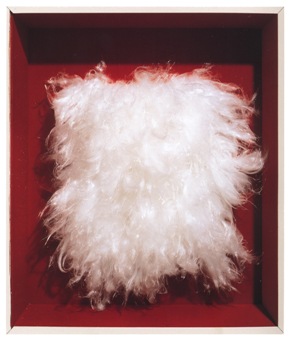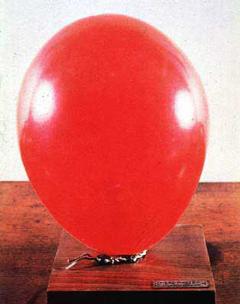Piero Manzoni facts for kids
Quick facts for kids
Piero Manzoni
|
|
|---|---|

Manzoni in 1960
|
|
| Born |
Piero Meroni Manzoni di Chiosca e Poggiolo
July 13, 1933 Soncino, Kingdom of Italy
|
| Died | February 6, 1963 (aged 29) Milan, Italy
|
| Nationality | Italian |
| Known for | Artist |
| Movement | Conceptual art |
Piero Manzoni (born July 13, 1933 – died February 6, 1963) was a famous Italian artist. He was known for his clever and sometimes funny way of looking at art. His work made people think about what art really is.
Manzoni's art was a bit like Conceptual art, which focuses on ideas more than the finished object. He often used very unusual materials instead of traditional paint or clay. His art also commented on the new world of mass production and buying lots of things in Italy after World War II.
Piero Manzoni died in his art studio in Milan on February 6, 1963. He was only 29 years old.
Contents
About Piero Manzoni
Manzoni was born in Soncino. He was the oldest of five children. His full name was Count Meroni Manzoni di Chiosca e Poggiolo.
He taught himself how to be an artist. Manzoni first showed his art in August 1956 at Soncino's Castle. He was 23 years old. His early art had bold brushstrokes.
Later, from about 1957 until he died, his art started to question what an art object should be. He was inspired by artists like Marcel Duchamp and Yves Klein.
Manzoni's "Achromes"
Manzoni's art changed a lot after he saw an exhibition by Yves Klein in 1957. Klein's show had 11 blue paintings that were all the same.
After this, Manzoni started making his own unique works called Achromes. These paintings always looked white, but they were actually colourless. He experimented with many different materials for these works.
At first, he used canvases covered in gesso, a white paint-like substance. He also used kaolin, a white clay used for porcelain. Later, he made Achromes from white cotton wool, fiberglass, rabbit fur, and even bread rolls. He even tried paints that would change colour over time!
Azimut Gallery and Unique Art
Manzoni opened the Azimut Gallery in Milan in 1959 with another artist, Enrico Castellani. They held many new and exciting art shows there.
"12 Lines" and "Bodies of Air"
One of his first shows was called 12 Linee (12 Lines) in December 1959. Soon after, in May 1960, came Corpi d'Aria (Bodies of Air). This art piece was a set of 45 balloons on stands. Buyers could choose to blow up the balloons themselves or have Manzoni do it, which changed the price!
"Consumption of Art"
In July 1960, Manzoni presented Consumption of Art by the Art-Devouring Public. For this, he hard-boiled 70 eggs and put his thumbprint on each one. He ate some himself, then gave the rest to the audience to eat. These eggs were called Uova con impronta (Egg With Thumbprint). This was a very unusual way to share art!
"Artist's Breath"
Around the same time as Bodies of Air, Manzoni created Artist's Breaths (Fiato d'Artista). These were red, white, or blue balloons that he had inflated himself. Each balloon was attached to a wooden base that said "Piero Manzoni- Artist's Breath." These works showed his interest in how art can be temporary.
Other Creative Works
- Magic Bases (Magisk Sockkel, 1961): These were wooden stands. If someone stood on them, they would become a "Living Sculpture."
- Lines of Exceptional Length (1960–61): Manzoni drew very long lines on paper. The longest was 7.2 kilometers (about 4.5 miles) long! He wanted to leave these lines in major cities around the world. If they were all joined up, they would be as long as the equator.
- Base of the World (Socle du Monde, 1961): This was a large metal stand placed upside down in a field in Herning, Denmark. It said, "The Base Of The World, Homage To Galileo." This piece suggested that the entire world is a work of art.
- Piero Manzoni; The Life And Works (1963): This book was published after he died. It had 100 clear plastic sheets bound to a white metal sheet. The only words were on the title page; the rest of the book was completely blank.
Art Shows and Collections
Manzoni's art was often shown at his own Galleria Azimuth. His work has also been featured in many art shows around the world. These include big shows at the Musée d'Art Moderne de la Ville de Paris (1991) and the Serpentine Gallery in London (1998).
You can find Manzoni's art in many public art collections. These include the Museum of Modern Art in New York, the Stedelijk Museum in Amsterdam, and the Tate Modern in London.
Manzoni's Legacy
The Fondazione Piero Manzoni is a family foundation in Italy. It looks after the artist's works and memory. His unique ideas continue to inspire artists and art lovers today.
See also
 In Spanish: Piero Manzoni para niños
In Spanish: Piero Manzoni para niños
- Conceptual Art
- Linee
- Corpo d'aria
- Arte Povera



